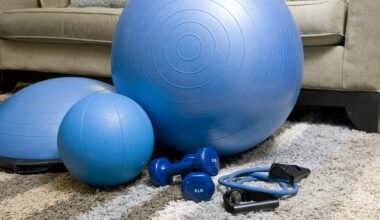Pilates Core Workouts for Seniors: Staying Strong Year-Round
As we age, maintaining core strength becomes increasingly vital for total body stability and overall health. A regular Pilates routine can enhance muscle tone, improve posture, and even alleviate common aches associated with aging. For seniors, low-impact exercises like Pilates ensure safety while effectively strengthening abdominal muscles. Consider starting with beginner-friendly movements to gradually build endurance and strength. Focus on exercises like the Pelvic Curl, which engages the core and strengthens the lower back. Incorporating resistance bands can also provide additional benefits without straining joints. Always consult with a healthcare professional before beginning any new fitness program. Taking these steps can help achieve a balance of strength and flexibility.
Furthermore, the controlled movements intrinsic to Pilates offer enhanced balance and coordination, which can prevent falls—one of the leading causes of injury among seniors. Pairing core workouts with breath control is essential, as proper breathing encourages relaxation and depth in your movements. For seniors, a regular Pilates routine should ideally include modifications tailored to individual abilities. Start slow, and listen to your body; this will lead to improvement and confidence within your practice. Even gentle workouts focusing on core strength can yield remarkable results over time, making it easier to perform daily activities and remain independent. With consistency, Pilates can transform a senior’s routine.
Effective Core Workouts
To maximize the benefits of Pilates core workouts, seniors should prioritize specific exercises that target abdominal muscles. The Hundred is one iconic Pilates move that warms up the body while strengthening the core. Begin by lying on your back, lifting legs into a tabletop position, and pumping your arms. This simple yet effective movement can show results when practiced regularly. Another valuable move is the Single-Leg Stretch, which enhances coordination while developing core stability. During this exercise, one leg stretches while the other does the opposite movement. Engaging in repetitive practice solidifies muscle memory and enhances overall effectiveness.
Additionally, the Pilates Roll Up blends flexibility with strength, allowing seniors to gradually enhance spinal mobility. It’s crucial to maintain control throughout this exercise to avoid injury. Another beneficial pose is the Side-lying Leg Series, focusing on the hip and oblique muscles. Strong side muscles contribute significantly to overall core strength. It’s advisable to use a mat for added comfort during these workouts. Not only does maintaining core strength help support bodily functions, but it can also promote overall mental well-being through improved posture. Each movement in Pilates works harmoniously, creating a stronger body and a more stable mind for seniors.
Safety and Practical Tips
When embarking on Pilates, safety is paramount, particularly for seniors. Always ensure proper warm-ups and cool-downs to prevent injuries. Engaging in light stretching before core workouts can prepare the muscles and joints. Using props like resistance bands and foam rollers can provide additional support. If joining a class, consider seeking instructors experienced in teaching seniors. They can provide modifications, ensuring that exercises remain within each individual’s limits. Avoid pushing into pain, and be mindful of any discomfort during workouts; adjust as required. Staying hydrated and resting when needed can make a remarkable difference during your Pilates journey.
Seniors should also consider joining a community class or group for added encouragement. Exercising with others fosters camaraderie and can motivate individuals to stay committed to a fitness routine. Look for local community centers or gyms that offer senior-focused Pilates classes. Additionally, online platforms can provide excellent resources for home practice. Reviewing instructional videos and following along can allow for flexibility in scheduling workouts. Remember, consistency is key; even short sessions, when done regularly, can lead to significant health improvements. Pilates offers a welcoming approach, promoting physical enhancement while emphasizing well-being and mindfulness.
Maintaining Motivation
Regardless of fitness levels, setting small, achievable goals can help maintain motivation while practicing Pilates. Tracking progress, whether through daily workout logs or journaling, can provide encouragement. Celebrate successes, both big and small, and enjoy the journey of self-improvement. Spicing up routines by varying the exercises prevents boredom and keeps motivation high. Try introducing new movements or additional sessions throughout the week to keep the mind and body engaged. Learning about the benefits of each exercise can also instill a deeper appreciation for the practice and enhance motivation to continue.
Lastly, always listen to your body; each person’s journey is unique. Tailoring workouts that suit personal capabilities while challenging oneself can be incredibly rewarding. Embrace the connection between mind and body as you practice controlled movements, allowing Pilates to foster strength and stability effectively. As seasons change, keep engaging your core, adapting workouts to reflect personal needs and abilities. Pilates encourages a sustainable fitness path, ensuring that seniors not only stay strong year-round but also enjoy the process of achieving a healthier lifestyle. Establishing a consistent routine benefits the body and nourishes the spirit.


